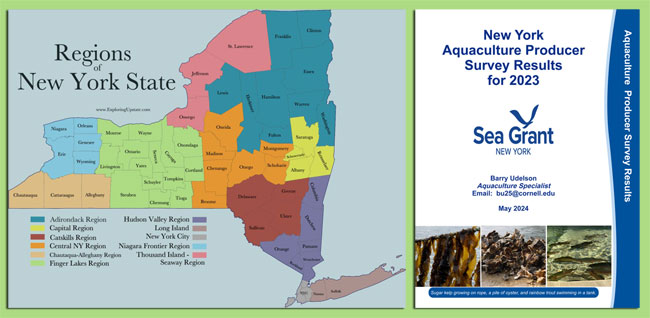
(At left) The map illustrates the statewide distribution of NY aquaculture operations responding to New York Sea Grant’s survey that was compiled into (at right) the comprehensive "Aquaculture Producer Survey Results" report.
Contact:
Barry Udelson, NYSG Aquaculture Specialist, E: bu25@cornell.edu, P: (631) 824-4934
A new survey illustrates status and production levels of NY’s aquaculture industry and allows for tracking industry changes over time
Stony Brook, NY, May 27, 2025 - New York’s aquaculture industry provides a local source of seafood, supports an extensive recreational fishing industry, and improves water quality and habitat with restoration efforts. New York Sea Grant (NYSG) developed a survey to collect relevant information to summarize the statewide aquaculture industry.
After obtaining industry input, NYSG distributed the survey to ninety-nine (99) aquaculture operations from all sectors (private, non-profit, and governmental) within New York. Seventy responded, identifying various aspects about New York’s aquaculture operations such as geographic location, age of the operation, number of employees, species and quantities produced, and production and distribution methods.
This new New York Aquaculture Producer Survey (pdf) provides a source of comprehensive industry information previously unavailable.
Project Partners/Funders:
• Cornell University’s Aquaculture Development Workgroup
• Funding: National Oceanic and Atmospheric Administration
More Info: New York Sea Grant
Established in 1966, the National Oceanic and Atmospheric Administration (NOAA)’s National Sea Grant College Program promotes the informed stewardship of coastal resources in 34 joint federal/state university-based programs in every U.S. coastal state (marine and Great Lakes) and Puerto Rico. The Sea Grant model has also inspired similar projects in the Pacific region, Korea and Indonesia.
Since 1971, New York Sea Grant (NYSG) has represented a statewide network of integrated research, education and extension services promoting coastal community economic vitality, environmental sustainability and citizen awareness and understanding about the State’s marine and Great Lakes resources.
NYSG historically leverages on average a 3 to 6-fold return on each invested federal dollar, annually. We benefit from this, as these resources are invested in Sea Grant staff and their work in communities right here in New York.
Through NYSG’s efforts, the combined talents of university scientists and extension specialists help develop and transfer science-based information to many coastal user groups—businesses and industries, federal, state and local government decision-makers and agency managers, educators, the media and the interested public.
New York Sea Grant, one of the largest of the state Sea Grant programs, is a cooperative program of the State University of New York (SUNY) and Cornell University. The program maintains Great Lakes offices at Cornell University, SUNY Buffalo, Rochester Institute of Technology, SUNY Oswego, the Wayne County Cooperative Extension office in Newark, and in Watertown. In the State's marine waters, NYSG has offices at Stony Brook University and with Cornell Cooperative Extension of Nassau County on Long Island, in Queens, at Brooklyn College, with Cornell Cooperative Extension in NYC, in Bronx, with Cornell Cooperative Extension of Ulster County in Kingston, and with Cornell Cooperative Extension of Westchester County in Elmsford.
For updates on Sea Grant activities: www.nyseagrant.org, follow us on social media (Facebook, Twitter/X, Instagram, Bluesky, LinkedIn, and YouTube). NYSG offers a free e-list sign up via www.nyseagrant.org/nycoastlines for its flagship publication, NY Coastlines/Currents, which it publishes 2-3 times a year.